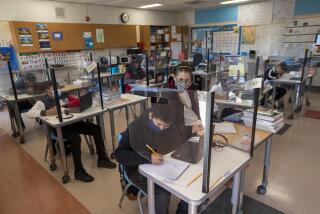SAN CLEMENTE : School Given Grant for Bilingual Work
- Share via
An elementary school in a predominantly Latino area of the city has been awarded a five-year federal grant to develop a bilingual immersion program enabling students to become literate in both English and Spanish.
Las Palmas Elementary School will receive about $172,000 for each year of the grant from the U.S. Department of Education to develop the language program, which will be offered to students on a voluntary basis starting in the fall of 1993.
Las Palmas is one of only six in the state and 15 in the country to receive such a grant.
“It’s a really exciting challenge,” Principal Doug Kramer said. “It’s an opportunity for all students to learn a second language. It really opens bilingual education to everyone.
“For the 21st Century, it’s going to be very important for kids to have two languages.”
Since the program will be the first of its type in the Capistrano Unified School District, the school will spend this year developing the curriculum, selecting textbooks, training teachers and preparing parents. A bilingual coordinator will be hired to supervise the program.
A similar voluntary bilingual immersion program already exists in the Saddleback Valley Unified School District.
Starting next fall, the Capistrano program will be available for at least one kindergarten and first-grade class, each made up of about 30 children, Kramer said. About 40% of the 800 children at Las Palmas Elementary School, a special magnet school open to any student in the district, are limited speakers of English or speak no English at all.
“The program is one way to really develop pro-social sentiments toward both cultures,” Kramer said. “Both English-speaking and Spanish-speaking kids will have something to offer. It’s really a choice we’re offering our students.”
Under the model program being considered for the school, an equal amount of English- and Spanish-speaking children will be involved in the classes. About 90% of the instruction will be in Spanish, with the rest in English. The amount of English instruction will increase as the children move up in grades, probably reaching a 50% level by the fourth grade.
Subject matter will be learned through the native language as well as through the second language, enabling students to become proficient in a second language, and to continue developing skills and proficiency in their native language, Kramer said.
Although still a point of some controversy, Kramer said, there is a large body of research, especially from the Canadian province of Quebec, where both English and French are taught in classrooms, that such dual-language immersion programs work.
“This is kind of new in California, but it’s not new if you look at it in a larger scale,” Kramer said.
More to Read
Sign up for Essential California
The most important California stories and recommendations in your inbox every morning.
You may occasionally receive promotional content from the Los Angeles Times.













